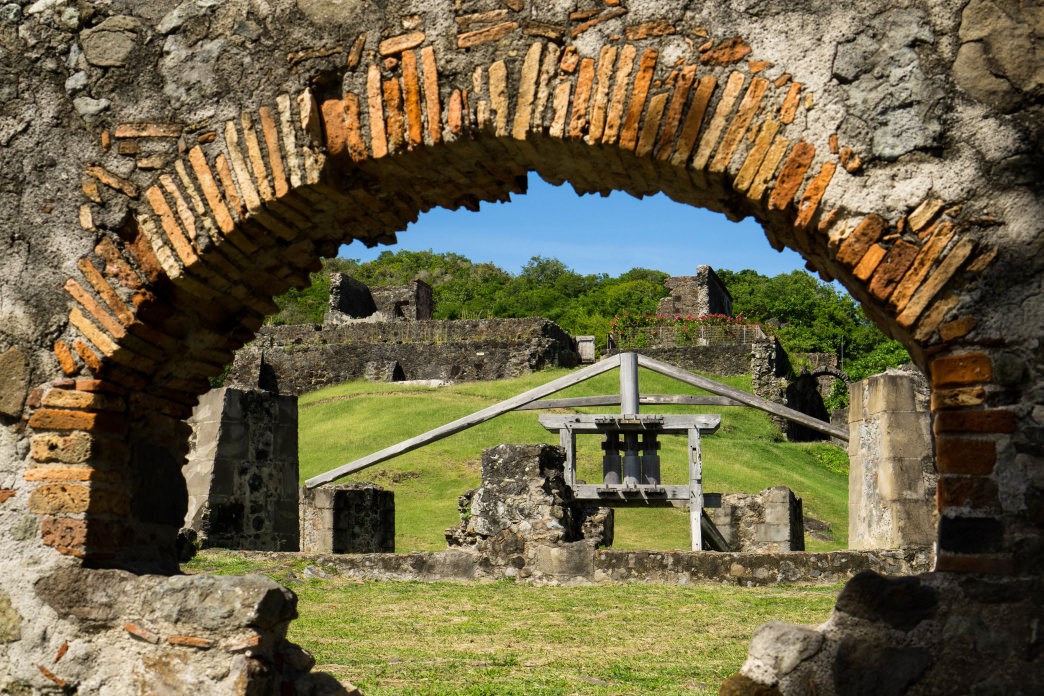Formed from volcanoes over ten million years ago, La Caravelle and Sainte-Anne Peninsulas include the oldest terrains in Martinique. Projecting into the Atlantic Ocean, the La Caravelle Peninsula encompasses unique panoramas and ecosystems. Deciduous forests morph into mangroves. Local fishermen toil in the shadow of the formidable Château Dubuc ruins. Imposing cliffs carved by unrelenting Atlantic waves lead to the quiet Baie du Tresor (Bay of Treasure). Here, tourists and locals alike can experience the most beautiful hike in Martinique.
At the easternmost point of the 12-kilometer long peninsula sits the National Natural Reserve of La Caravelle. It was created in 1976 to protect this rich cultural and biological treasure. To access the trails, take the D2 through Trinité towards Tartane, a classic Martinique fishing village where the fresh catch of the day is served at seaside restaurants. After Tartane, follow the surfers chasing swells at Surfers’ Beach. The D2 becomes a gravel road, ending at the Château Dubuc parking lot. The rest of your adventure will be on foot.
Two trails offer a complete, well-marked tour of the peninsula’s varied ecosystem. It is highly recommended to tackle this hike in the morning, as the sun sets rather early on Martinique. Both routes feature mangroves, deciduous forest and beach access. The shorter trail is almost two kilometers, and the longer hike encompasses it. The principle circuit is a roughly nine-kilometer hike that is sure to take your breath away.

kzoop
The hike begins on a wide dirt path that ambles under tree canopy to the Caravelle Lighthouse, built in 1861. Enjoy the shade, as later sections are not as protected from the elements. Vibrant hermit crabs crisscross the path and evade hikers’ footsteps. The slope steadily increases to the lighthouse, perched at 157 meters above the sea.
A stunning 360-degree panoramic viewpoint gives hikers a bird’s-eye view of the peninsula and Martinique’s Atlantic coast. Thanks to a beautifully designed orientation table, visitors can identify nearby mountains and islands, including the celebrated Mount Pelée. The hike continues past a weather station where you can read a harrowing account of lighthouse keepers who braved Category 5 Hurricane David in 1979.

kzoop
The scenery along the path changes rather abruptly toward Anse Chandelier. The forest dwindles to grasses and flowering shrubs, leaving little protection from the harsh Caribbean sun. An anse is a cove, but swimming is not recommended here. Waves endlessly batter cliffs, making for a awe-inspiring reminder of the unharnessed power of nature. Basalt columns and fossilized coral reefs reveal the rich geological history of the earliest-formed land in Martinique. The cliffs resemble Brittany, France; Donegal, Ireland; or Point Reyes, California, depending on whom you ask. Straying from the path can be lethal, as the only inhabitants of this harsh setting are crabs and frigate birds, who nest in the cliffs.
The trail meanders through rolling grasslands, occasionally interrupted by cacti that dot coastal trails throughout all of Martinique. At the smaller cliffs of Anse Bois Vert, two palm trees seem out of place among the rest of the low-lying foliage. Elevation gradually increases as you reach Caracoli Point, a 90-meter rise that marks the extreme eastern edge of Martinique.

kzoop
The final ascent is the most brutal part of the hike, but the view of the islands around Robert is as magnificent as the refreshing breeze that greets you! After admiring the view – and perhaps planning an island hopping adventure – continue in the direction the Bay of Treasure. This section of the hike becomes extremely muddy after heavy rains.
The path is long, but shrub-like trees form tunnels that block the sun and shelter endangered bird species. The moqueur gorge blanche, a mockingbird with a white throat, lives solely on Martinique and the neighboring island of Saint Lucia. If you’re lucky, a carouge, a handsome species of oriole exclusive to Martinique, will grace the trail.
Mancenilliers mingle with mangroves as the forest gives way to marsh. These trees protect wildlife, but they produce a sap that is toxic to humans. Avoid the leaves as well as the fruit, and certainly steer clear of these trees when it rains. Even contact with water running off of them can cause a rash. Mancenilliers are found throughout Martinique, but the red paint around their trunks makes them easy to avoid.
The final stretch of trail ambles next to the shoreline of the Bay of Treasure. This sublime beach is partially hidden among mangroves, only a few steps from the path. Enjoy a well-deserved dip at this secluded paradise, named for the jasper and other eye-catching minerals that occasionally wash ashore.

kzoop
The trail ends where it began at the ruins of Château Dubuc, an important testament to Martinique’s divisive past. A former habitation (plantation), Dubuc housed a bustling sugarcane production during the 18th century. The plantation was abandoned for over a century, but it has been skillfully restored as an enlightening historical monument. Its isolation and proximity to the sea yields dramatic vistas.
La Caravelle Peninsula is an area of exceptional geologic and ecological diversity. The oldest land in Martinique contains wildlife exclusive to the island and over 150 species of fauna. Imposing cliffs, sprawling mangroves, a deciduous Caribbean forest, rolling grasslands, and the tranquil bay create an extraordinary mosaic of nature’s splendor. The enchanting loop that connects them is easily the most beautiful hike in Martinique.
Originally written by RootsRated for Atout France.
Originally written by RootsRated for Atout France.
Featured image provided by kzoop

 Château Dubuc and all of its beauty.
Château Dubuc and all of its beauty.